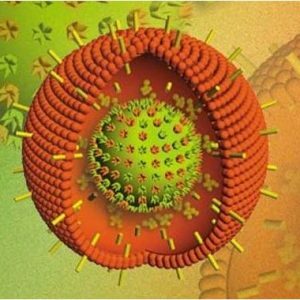Brucellosis: Causes, Symptoms, Consequences
 Brucellosis is a dangerous infectious allergic disease that is transmitted to humans from animals( cattle).This disease affects the cardiovascular, nervous, genital systems, as well as the musculoskeletal system.
Brucellosis is a dangerous infectious allergic disease that is transmitted to humans from animals( cattle).This disease affects the cardiovascular, nervous, genital systems, as well as the musculoskeletal system.
What causes brucellosis and ways of transmission of the disease
The causative agents of this disease are bacteria of the genus "Brucella".These bacteria are highly invasive and able to penetrate through undamaged mucous membranes. They are stable in the external environment. In the human body, bacteria fall through the meat, animal hair, and dairy products.
As mentioned above, brucellosis is transmitted to a person through large and small cattle: sheep, goats, pigs, cows. Sometimes the source of infection can be yaks, camels or horses. The bacterium is excreted from the body of animals through milk, excrement and meat.
A person can catch contact-household, aerogenic or fecal-oral route. The greatest danger to humans is provided by: dairy products( cheese, milk, cheese, kumis and the like), wool, meat. Meat represents a lesser threat to health, as it is processed thermally. With proper treatment, brucellosis bacteria die.
Unfortunately, doctors often had to deal with such cases when a person was infected by aerogenic means. This can happen when you cut or sort the wool of an infected animal, when cleaning the area or when processing raw materials from animals. Brucellosis bacteria can penetrate even through the mucous membranes of the eyes.
Most often this disease affects people who live in rural areas. This is due to the fact that they are in close contact with animals that transmit the infection.
What happens during brucellosis?
The bacterium brucellosis penetrates through damaged skin or mucous membranes. Bacteria penetrate into the lymph nodes and accumulate in them. This phase of the disease is called lymphogenous. Its duration depends on the protective forces of the organism, as well as on the activity of bacterial multiplication. With the prolonged accumulation of bacteria in the body, an immunological alteration of the organism takes place.
After the lymphogenous phase, hematogenesis occurs. At this phase, there are pronounced symptoms of the disease. The normal functioning of the autonomic nervous system under the influence of substances that are released by bacteria is disturbed.
Blood pathogens are spread through the body and then fixed on various organs. Diffuse changes begin to develop in the affected organs and tissues. The person often has allergic reactions. In addition, patients with brucellosis suffer from nervous, musculoskeletal and other systems.
If the disease is not treated, then it goes into a chronic form. In chronic brucellosis, various disturbances are formed in various systems and organs: a functional character, and sometimes an irreversible organic character, in which persistent cicatricial changes develop.
Symptoms of the disease
The incubation period lasts up to four weeks. Sometimes doctors can extend it to three months( with latent infection).As already mentioned above, brucellosis can be acute, subacute and chronic.
The acute form of the disease develops slowly: from several days to several weeks. During this period, patients complain of sleep disorders, feelings of weakness, malaise, joint pain and various muscle groups, and pain in the lower back. On examination, doctors note an increase in peripheral lymph nodes. As the disease progresses, chills appear, sweating and body temperature increase, the spleen and liver grow.
If the disease develops rapidly, the body temperature rises to 40 degrees during the first days. Chills can last up to four weeks. However, most often the condition of patients at this stage of the disease is satisfactory, so few people rush to the hospital for examination.
Patients complain of poor sleep and headache, increased irritability and pain in the muscles and joints. Upon examination, the doctor can identify the hyperthermia of the neck and face, the pallor of the skin. Most often, cervical and axillary lymph nodes increase. Sometimes a doctor can feel for small, painful tight nodules in the muscle area. As a rule, in the acute period of the disease, the activity of the musculoskeletal system, the peripheral nervous system and the activity of the sexual sphere are disrupted.
Subacute form. At this stage of the disease, the above symptoms become more pronounced. Body temperature and chills can appear at any time of the day. The pain in muscles and joints becomes stronger. Sick of the person are more often disturbed by disturbances of a dream, thus the appetite worsens, the muscle weakness develops, thirst and dryness in a mouth appears, constipations often appear.
Doctors at the examination of the patient find violations from the cardiovascular system. Also, the functioning of the digestive tract is impaired. Sometimes in patients, doctors diagnose the development of slow serous meningitis.
With this form of the disease, the patient often develops various allergic reactions: dermatitis, eczema and the like. There are pronounced disorders of the musculoskeletal system: synovitis, arthritis and polyarthritis, bursitis and the like. In women, there is a disorder of the menstrual cycle and endometritis, spontaneous abortions are also possible. In men, there are orchids or epididymitis. The lesions of the nervous system can manifest in the form of ischioradiculitis and plexitis.
Chronic brucellosis occurs when the disease has not been diagnosed and cured in time. Periods of exacerbation of the disease can be replaced by a prolonged remission. In this form of the disease, various organs and systems are affected.
Signs of changes in the musculoskeletal system are characterized by the development of long-flowing bursitis, perichondritis, periostitis, arthritis, tendovaginitis. Very often the departments of the spine are affected.
The lesions of the nervous system are expressed in the form of plexitis, radiculitis, neuritis of the auditory nerve, intercostal neuralgia, optic neuritis, and sensitivity disorders. In rare cases, it is possible to develop a diencephalic syndrome and meningoencephalitis.
Consequences of
Sometimes after treatment residual effects of a functional nature persist: sweating, changes in the neuropsychic sphere, irritability, arthralgia. With severe consequences, irreversible fibrous-cicatricial changes are formed, into which nerve plexuses, trunks and roots are involved. This can trigger the appearance of various neurological symptoms. Changes can also occur from the musculoskeletal system: deformity of the joints, muscle atrophy, ankylosis, spondylosis and so on. Sometimes surgical intervention is required to eliminate these disorders.
In case of severe consequences, the patient may be given a disability group for life. As you can see, brucellosis is a very serious disease that requires timely treatment.



